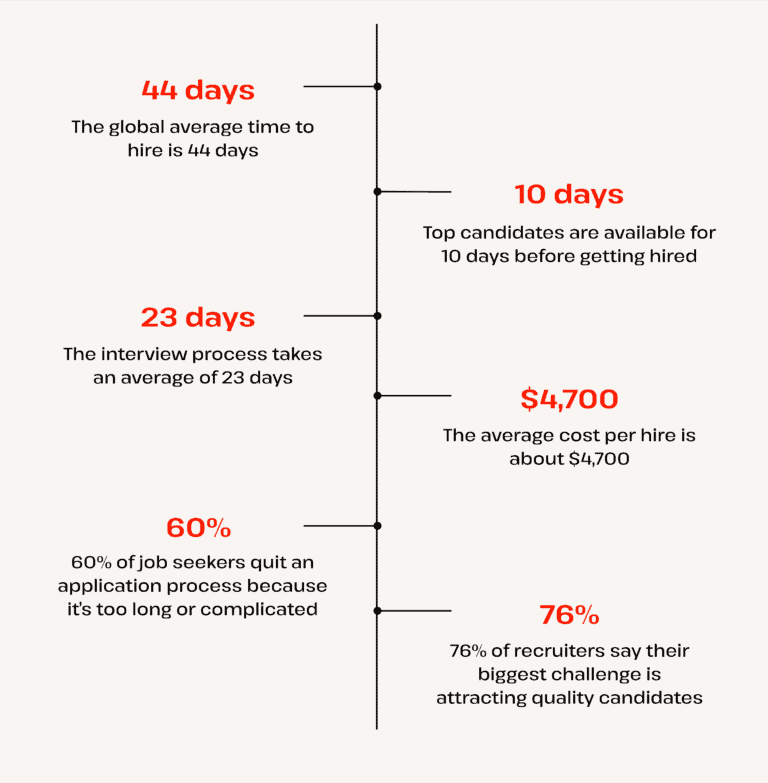Which Is Better: Strategic or Traditional Staffing?

Apr 15, 2025
Last updated on May 6, 2025
Are you filling job openings as they appear, or are you building the workforce needed to drive your company's future? Understanding the difference between traditional and strategic staffing is key to ensuring your talent approach actively supports your business goals.

Key Takeaways
- Internal hires save recruitment time and cost 3-5 times less than external hires, making strategic staffing financially sound.
- Companies using strategic staffing can reduce time-to-hire from 75 days to just 28 days, providing critical competitive advantage.
- Only 10% of companies have formal talent gap identification processes, creating opportunity for forward-thinking leaders.
- Internally promoted employees have a 70% chance of long-term retention versus average rates of 45%.
- 64% of East Asia-Pacific companies cite talent acquisition as their top growth barrier—not funding or capital.
How you acquire talent directly impacts your business success. This post compares reactive traditional staffing with forward-thinking strategic staffing approaches, helping Vietnamese business leaders determine which method best serves their company’s needs. Understanding these differences is essential for aligning your talent acquisition with both immediate requirements and long-term business goals.
What is traditional staffing?
Many businesses default to traditional staffing without examining its underlying assumptions or long-term implications. Before deciding if this approach serves your organization, it’s essential to understand its fundamental characteristics, operational patterns, and inherent limitations.
Focus on immediate vacancies
Traditional staffing reacts to hiring needs as they arise. This approach addresses current gaps rather than future needs, treating recruitment as a separate, transactional process disconnected from broader business goals.
In practice, this means waiting until an employee leaves before seeking a replacement, or rushing to hire when a new project creates sudden demand. Employment data shows the average time-to-hire reached 44 days in 2023, an all-time high, and this trend has been rising consistently for the last four years. These trends make it harder for organizations to secure talent quickly and efficiently.

Common applications and limitations
Traditional staffing works for predictable roles in stable environments and for urgent, temporary needs. However, it often leads to rushed hires, skill mismatches, and higher long-term costs due to turnover.
Temporary staffing services can address immediate needs, but research indicates external hiring costs 3-5 times more than promoting or reassigning employees. Traditional approaches also risk misalignment with evolving business strategy, as they rarely account for upcoming skill requirements or strategic shifts.
|
Traditional staffing creates a costly cycle—positions stay vacant longer (44 days on average), increasing pressure to hire quickly, which leads to poor matches and higher turnover. This perpetuates the cycle of reactive hiring while costing 3-5 times more than internal solutions. |
What is strategic staffing?
While traditional staffing focuses on filling empty seats, strategic staffing fundamentally reimagines the relationship between talent acquisition and business success. This forward-looking approach has gained traction among industry leaders seeking sustainable competitive advantage through human capital.
Focus on long-term business alignment
“Strategic workforce planning removes unnecessary friction. The better you can plan, the faster you can deploy people to business needs, and the faster you can solve customer issues”
- Dermot O’Brien, former CHRO & Chief Transformation Officer at ADP –
Strategic staffing is proactive, aligning workforce planning directly with the company’s strategic goals 3-5+ years ahead. It anticipates future talent needs, identifies potential skills gaps, and builds talent pipelines. This approach integrates recruitment with broader talent management, including development, retention, and succession planning.
|
Strategic staffing isn’t just about hiring—it’s a comprehensive approach that aligns your workforce capabilities with your business strategy, directly impacting your competitive position and ability to execute on growth plans |
Key advantages for growth
An effective staffing strategy creates a more adaptable workforce ready for market changes and innovation. It reduces turnover costs and improves productivity. Research shows that companies filling strategic roles with permanent hires rather than temporary contracts improve retention by nearly 47% in those positions.
A South American bank demonstrates these benefits. After overhauling its tech talent acquisition approach with strategic workforce planning, the bank increased hiring volume by 30% while reducing time-to-hire from 75 to 28 days, according to McKinsey & Company research.
This approach also enhances employee engagement through better role fit and career development. This matters because 63% of workers who quit in 2021 cited lack of advancement as a major reason for leaving.

Strategic vs traditional staffing key differences
How does strategic staffing differ from traditional staffing? The strategic approach fundamentally differs in several key dimensions:
|
Dimension |
Strategic staffing |
Traditional staffing |
|
Planning horizon |
Proactive, anticipates needs |
Reactive, responds to vacancies |
|
Timing |
Long-term (3-5+ years) |
Short-term (immediate needs) |
|
Business alignment |
Directly tied to strategic goals |
Often siloed from strategy |
|
Talent approach |
Integrated talent management |
Primarily recruitment-focused |
|
Primary outcome |
Competitive advantage & agility |
Filling open positions quickly |
Which approach is right for your business?
it depends on your organization’s specific context, growth trajectory, and strategic priorities. Rather than viewing these models as binary choices, forward-thinking leaders often implement a thoughtful hybrid approach tailored to their unique circumstances.
When traditional staffing can work
Traditional staffing fits highly stable businesses with predictable, routine hiring needs. It works well for temporary or non-critical roles where long-term fit matters less. It can also serve as one component of a larger strategy, handling immediate gaps while strategic planning addresses core roles.
Even in these scenarios, adding strategic elements improves outcomes. Working with a staffing agency can help you build relationships with potential candidates before needs arise, speeding up the traditional process when positions open.

Why strategic staffing drives better business outcomes
A strategic staffing plan becomes essential for companies pursuing growth, navigating change, or operating in dynamic markets like Vietnam. It directly addresses concerns about talent shortages, cost control, innovation, and sustainability.
This approach builds a workforce that provides competitive edge and supports future goals. According to the World Economic Forum, 64% of companies in East Asia-Pacific cite difficulty attracting talent as their biggest barrier to transformation, compared to only 28% citing lack of capital. Finding the right people proves harder than finding funding, making strategic staffing services crucial.
|
In today’s competitive Southeast Asian market, your ability to attract and retain top talent is a more significant determinant of growth than access to capital. Strategic staffing doesn’t just fill roles—it secures your company’s future |
Even if immediate needs seem manageable with traditional approaches, incorporating strategic elements like skills gap analysis and basic succession planning prepares the business for the future. This balanced approach addresses present requirements while building toward long-term goals.
Evaluate your business trajectory—if growth, innovation, and long-term resilience are priorities, adopting a strategic staffing vs traditional staffing mindset is crucial. Start by aligning HR planning with your 3-5 year business strategy, identifying future critical skills, and investing in talent development. Don’t wait for talent gaps to become crises; proactive planning is essential for sustained success in Vietnam’s competitive landscape. Consider partnering with HR staffing experts to develop and implement an effective staffing strategy tailored to your unique goals.

Solve your HR problems!
6th Floor, Star Building, 33 Mac Dinh Chi, Saigon Ward, Ho Chi Minh city, Vietnam




